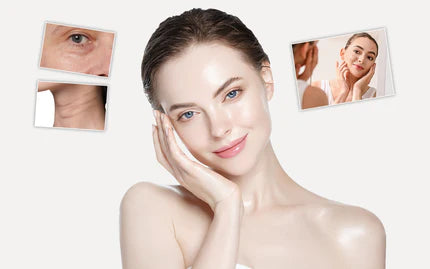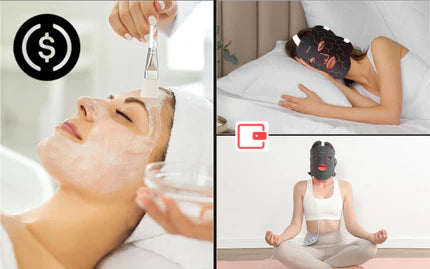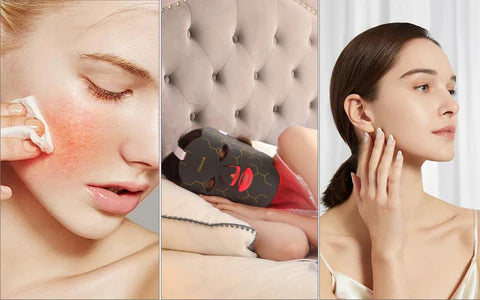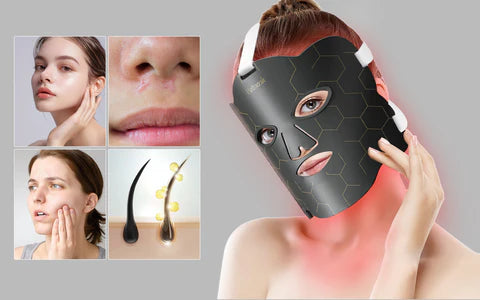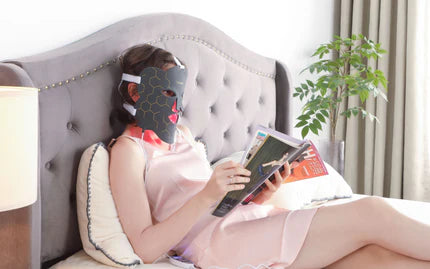Red light therapy (RLT) is making waves with its claim to refresh skin and heal our bodies gently, without any cutting or poking. It started off helping astronauts and space plants and now, it’s becoming a big deal for people looking to boost their skin’s health right here on Earth. But with all the buzz, there are still questions and concerns. Let’s break down how RLT works, what it can actually do for us, and, just as important, if it’s safe to use.

What Red Light Therapy Can Do for You
Red light therapy (RLT), originally used by NASA to aid healing in astronauts, is now available for home use, promising better skin health. This method of treatment known also as biostimulation or photobiomodulation has moved from its initial stage of assisting with the growth of plants in space to help cure certain cancers through photodynamic therapy.
As far as professional use or personal use goes, RLT causes skin rejuvenation by stimulating collagen synthesis as well as reducing inflammation. By means of particular wavelengths within the light spectrum that energize mitochondria found inside cells, some think that this process could be aiding them repair themselves more efficiently.
However much enthusiasm there may be around RLT though, one should note that research into all the benefits it offers is still ongoing. Although positivity can be seen about its possibilities, medical authorities are pressing for further research so that they can confirm its uses fully. We will begin understanding well-backed information rather than unproven claims when we learn more about RLT fostering a wider understanding of how best it can help us meet our healthcare needs.
How Does Red Light Therapy Work at the Cellular Level?
Red light therapy (RLT) works surprisingly directly, it uses red light to boost mitochondria, which are often referred to as the ‘powerhouses’ of our cells. Increased energy in our cells is believed to make them work better thereby resulting in things like more collagen leading to firmer skin plus improved blood flow that brings nutrients to the skin.
The secret of RLT lies in using particular frequencies of light that can go through different layers of the skin without causing any damage like UV radiation does. When you think about RLT, consider it as a kinder cell energizer that invigorates your body’s natural healing systems in a non-invasive way and this becomes interesting, particularly for skincare as well as relieving inflammation which is implicated in most skin problems.Click here to learn more about: how red light therapy works.
What Are the Safety and Practical Considerations of Red Light Therapy?
1. Assessing RLT’s Safety Measures
Red light skin treatment has been largely associated with safety, especially when compared to potential dangers like ultraviolet rays. The gentle nature of RLT makes it possible for one to skip through many complications related to highly aggressive anti-aging methods since it avoids harsh chemicals and invasive processes.
2. Potential Side Effects and How to Avoid Them
However, minor side effects can still occur during RLT despite being non-invasive. It’s important to use protective eyewear because our eyes are susceptible to bright lights causing eye fatigue. Temporary reddening of the skin may also be experienced by users after sessions; this generally subsides quickly without intervention being necessary. Consistency with recommended exposure times becomes paramount in order to avoid overusing (which is common among enthusiasts).
3. Professional vs. At-Home Devices: A Cost-Effectiveness Evaluation
Costs, convenience, and intensity all must be weighed when choosing between professional treatments or home devices that use light therapy technology for treating collagen loss leading to wrinkle on your face appearance better! Clinical-grade ones might provide stronger red light doses that might result in faster outcomes. This is in contrast to the convenience and privacy of home units, which typically have less powerful settings. To ensure the best results, users should bear in mind their device choice and follow its guidelines.
4. Best Practices for At-Home RLT Use
For those who decide to go for home-based RLT, it is important to know how to use the technology correctly. Failure to do so can reduce effectiveness or even increase risks unnecessarily. Users should familiarize themselves with specific protocols related to their devices such as treatment duration and frequency for ensuring safety and effectiveness.
5. The Commitment Factor in RLT
Red Light Therapy cannot be a quick fix but involves a long-term commitment where consistency matters. Hence anyone contemplating RLT must prepare for this aspect considering both the financial costs of acquiring a device and the time commitment needed for regular visits/ sessions. Abiding by slow improvements seen with RLT suggests that one needs patience and persistence on his or her journey to better skin.
Should You Include Red Light Therapy in Your Daily Health Routine?

1. Looking at Costs and How Easy It Is to Get
While contemplating the use of red light therapy (RLT), you need to keep in mind how much it will cost and how easy it is. Most insurance companies do not pay for RLT as they consider it more cosmetic or still being researched. Hence, this means that you will have to pay out of your pocket whether you are purchasing a device for home use or going to professional services. This is a point where prices can vary significantly; hence, this aspect requires you to think about what could fit into your budget.For a cost-effective alternative, explore skincare solutions like Hottoerak's Therapy Masks, known for their high-quality and affordability.
2. What to Expect from the Treatment
But starting with RLT isn’t just about money; it takes time too. Changes aren’t seen overnight. Usually, after several treatments over weeks or even months, people usually realize some improvement. Since everyone’s different, how quickly and well it works can change a lot from one person to another. This knowledge may also help make fitting RLT into your life less difficult than expected.
3. Making It Work for You
There are so many factors on which the effectiveness of RLT can depend such as age, skin type, and what condition you’re using it for. Not all RLT devices are created equal – there are different ones that may be better suited specifically for certain issues like these. Light therapy can work magic if done correctly however choosing the right one is very important since an individual cannot choose any Red Light Therapy product they come across.
4. Talking to a Pro
Considering that we have so many reasons why talking to healthcare personnel before embarking on Red Light Therapy is vital with all information available then speaking with a health care provider prior would be wise. The same goes if say you have any medical conditions or specific desires concerning trying out red light therapy (RLT). An expert will offer you advice and ensure that you make well-versed decisions about your health.
How Effective Red Light Therapy Really Is
Potential and Promise in Dermatology
Red light therapy (RLT) has become popularly acknowledged for its possible effectiveness against many skin conditions. From remodeling aged skins up to wound healing, it is also being attempted by doctors who want hair growth back on bald spots caused by pattern baldness. According to their proponents, these therapies could alter treatments for dermatological patients by refining textures of skin alongside reducing inflammations such as eczema, psoriasis, or rosacea.
Current Research and its Limitations
Some positive stories and preliminary research support such claims, but science is not done. Many researches involve only a few subjects which means we cannot yet fully rely on their results. Frequent lack of control groups for comparative purposes in these researches is so bad as it is an essential requirement to prove that therapy works or does not work. Some investigations have been conducted on animals or cells in the laboratory; however, there may be no equivalent effects in humans.
Need for Rigorous Clinical Trials
To verify whether RLT works with certainty, more robust studies are required such as randomized placebo-controlled trials — the highest standard in medical research. These types of experiments contrast red light therapy with either no treatment or other therapies thereby providing a clear understanding of its efficiency.
Final Thoughts
Red light therapy (RLT) provides a non-invasive and new approach that might give your skin a great look as well as promote healing. If you are thinking of using alternative therapies on your skin or for general wellness, it may be worth exploring red light therapy. It is simple to use and has been proven to have very few side effects. However, remember that individual differences should always be taken into account when comparing results, and talking to a healthcare provider is always recommended in order to ensure that RLT matches in with what you specifically need and want regarding your health. With its increasing popularity and ease of access, Red Light Therapy could be the answer to all your personal care needs.


